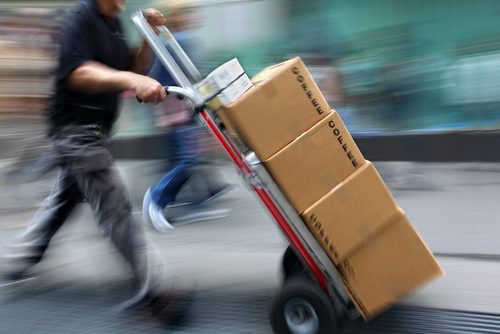With major retail players, such as Amazon and Google, throwing their hats into the same-day delivery fray, it is clear that the industry senses the fulfillment model has a future among consumers. However, thought leaders debate if the model will truly change the delivery game.
Online shoppers in both the U.S. and Canada are willing to sacrifice delivery speed for a lower shipping cost, according to a recent survey conducted by Purolator International. As many as 63% of U.S. shoppers and 76% of Canadian shoppers also rank shipping cost as a very important priority that affects their online purchasing habits. Conversely, only 28% of U.S. shoppers and 22% of Canadians rank delivery speed as a very important part of their decision, although 46% of U.S. shoppers and 51% of Canadian shoppers value delivery speed as “somewhat important.”
“When you talk about the broadest piece of online shipping, it is still people shipping deliveries to their home,” Jon Routledge, VP of Sales and Marketing at Purolator International. “For those mass orders, cost is still a big factor. Whether that will change as the cost dynamics of faster shipping change, we’ll have to wait and see. But I think you have a general demographic that says, ‘I am willing to wait a given period of time if it means I get the items for nothing. If it’s an emergency or I’m going out this evening and I want to wear that outfit, then as an exception, I’ll go and pay for it.’”
Amazon Introduces Free Same-Day Shipping
With shipping cost being an important factor for consumers, achieving the combination of low-cost and quick delivery will likely be the springboard that puts retailers ahead of their competitors.
Amazon appears to be the first company to harness both qualities: The e-Commerce giant first introduced free same-day delivery as part of its Prime Now service, which initially launched in New York in December 2014. The service offered one-hour delivery on select items for $7.99, while the two-hour delivery was free of charge. Prime Now is currently available in Atlanta, Austin, Baltimore, Brooklyn, Dallas, Manhattan and Miami.
More recently, the company waived the $5.99 delivery fee for Prime service members in select U.S. metropolitan areas that make a purchase of $35 or more on the site. Amazon is further expanding the Prime offering to the Tampa Bay and San Diego markets, marking 14 major metropolitan areas that now provide free same-day delivery. Amazon.com displays a Prime Free Same-Day logo on eligible product pages.
On the surface, Amazon’s new deal seems to be a breakthrough for the fulfillment world, however, there are concerns, especially when looking at the potential financial impact for the retailer.
“Given how much attention was paid to their rising shipping costs and investors’ apparent growing impatience when it comes to Amazon’s profitability, I’m not sure that I would call this a game changer,” said Nikki Baird, Managing Partner at RSR Research in a discussion on RetailWire. “It’s definitely been a long time coming — retailers have been fretting about it for a couple of years now… It’s only a game changer if it is sustainably affordable, and I haven’t seen any proof yet that it is.”
Of course, like many industry trends, there is also the sense that the model may be nothing more than a fad. If Amazon is unable to successfully deploy a combination of same-day delivery and low shipping costs, then it would be difficult to find many other retailers with the resources to execute the strategy on their own.
“This will be another ‘have to have it for Millennials’ and then it will fade into the background,” said Tom Redd, VP of Strategic Communications at SAP Global Retail in the same RetailWire discussion. “Many of the people using same-day are from the generation of ‘have to have it now.’ Most of that generation just go to the store and get what they need. The other segment of special needs shoppers want to use their computers or phones to do this. To them it is exciting and new and they love having someone deliver something to their place or to them. Let the noise and hype flow, it is just another exciting moment in the never ending attempts to make retail more than it really is.”
Retailers Begin Catching Up To Speed
Same-day delivery offerings are still relatively rare in the industry aside from select brand names, with only 15% of retailers worldwide providing the service, according to The 2015 Seamless Retail Survey from Accenture.
Despite the small percentage, the value of merchandise delivered via same-day delivery in 20 U.S. cities is expected to rise 550%, from $100 million in 2014 to $620 million in 2015, according to a report from BI Intelligence. By 2018, this total is expected to reach $4.03 billion, indicating that there is plenty of room for more retailers and brands to enter the market.
At the end of 2014, Google released its Express service, which provides same-day or overnight delivery for partner retailers in eight major metropolitan areas. Walmart has even tested same-day delivery on a smaller scale, making its online grocery shopping service exclusive to San Jose, Calif., San Francisco and Denver residents. The company has not shown any indication that it will expand beyond the three markets.
Big box brick-and-mortar retailers appear to be the most likely to make the investment. Macy’s has plans to expand its same-day delivery program, powered by crowdsourced delivery startup Deliv, to more markets later in 2015. In June 2014, Target made its Rush Delivery offering available in the Boston, Miami and Minneapolis, Minn. markets. The retailer may expand the service to other markets in the future, according to the company web site.
“We’re starting to see retailers adding same-day service or even within-the-hour service,” said Leslie Hand, VP at IDC Retail Insights. “It’s not always free, but that’s okay. Enabling this in a cost-effective way requires a lot of work in their fulfillment capabilities. They have to allocate the items in the right place to ship to the customer destination so that the customer could enter their enterprise — in-store, online or on the mobile device — and not even have to know which store it is they’re talking to.”
Given the high risks involved with same-day delivery, understanding the consumer base from an analytical perspective is a prerequisite to creating a proper fulfillment strategy. Retailers looking to deploy same-day delivery need to track metrics such as number of consumers within a specific trade area and frequency of purchase. For example, retailers have at least a 90% order fulfillment rate (preferably higher) for the inventory they make available for same-day delivery, according to Anne Brouwer, Senior Partner at retail consulting firm McMillan Doolittle.
“If you’re at 85%, pretty soon consumers will likely say they can’t get what they want for same-day delivery, and it’s not going to be a profitable or at least a break-even solution,” Brouwer said in an interview with Retail TouchPoints. “Even though retailers such as Macy’s, Kohl’s, Target and Walmart have hundreds or even thousands of local distribution centers — stores — they really have to manage their inventory. You have to make sure that what you’re making available to consumers to purchase online, you can lock down once your customer hits buy. That’s a huge investment.”
Entering the same-day delivery market has not been an easy task for every major retail player. EBay initially had plans to operate its one-hour delivery service, eBay Now, in as many as 25 U.S. cities by the end of 2014. After testing last mile services for more than a year, it decided to change its approach in December 2014, migrating the eBay Now standalone app onto the eBay web site and its core mobile apps. The eBay Now branding continues to exist, but is powered through its eBay Local service. As of June 1, 2015, the eBay Now service is offered in eight U.S. metropolitan areas.
The Emergence Of Third Parties
Many retailers have taken to third parties to carry out their same-day delivery experiments. Particularly, services such as Instacart, Postmates, Deliv and Shutl have all provided retailers with solutions that take the act of delivering the product out of their hands.
Uber, known for its crowdsourced transportation model, plans to implement same-day delivery into its arsenal of services, reportedly partnering with mobile shopping app Spring to test the program.
These companies could have a heavy hand in the future of same-day delivery, particularly for retailers that are not large enough to handle the costs and logistics on their own. In fact, on-demand socially networked delivery services are expected to perform 90% of all intra-day direct to consumer deliveries by 2018, according to the 2015 IDC FutureScape Worldwide Retail Predictions report.
“I think Instacart and Uber have a role to play, because Walmart, Target or Macy’s probably can afford whatever they want to do in that regard,” Brouwer explained. “There are a lot of other retailers where the scale of that execution is such that they may find that it is much more economical to use a third party. Think about supermarkets, for example. Some of them may be regional or specialty in the ability to have an independent third party — even if it’s a break-even from an expense standpoint — so it may be a much better solution than investing in it themselves.”
With an increasing number of retailers taking the initiative to push forward with same-day delivery, the third parties may be a major determinant with the success of the model as a whole. Even with that in mind, the success of the delivery model will always hinge on the retailer’s understanding of their consumers’ purchasing desires. While same-day delivery might not be a complete necessity for some retailers, those that have a consumer base with a penchant for on-demand purchasing habits would do well to at least explore the option.













